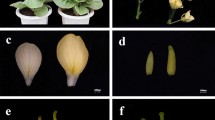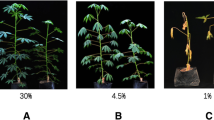Abstract
Polyploidy is an important evolutionary factor in most land plant lineages which possess more than two complete sets of chromosomes. Radish (Raphanus sativus L.) is an economically annual/biennial root vegetable crop worldwide. However, the expression patterns of duplicated homologs involved in the autopolyploidization remains unclear. In present study, the autotetraploid radish plants (2n = 4x = 36) were produced with colchicine and exhibited an increase in the size of flowers, leaves, stomata and pollen grains. The differential gene expression (DGE) profiling was performed to investigate the differences in gene expression patterns between diploid and its corresponding autotetraploid by RNA-Sequencing (RNA-Seq). Totally, 483 up-regulated differentially expressed genes (DEGs) and 408 down-regulated DEGs were detected in diploid and autotetraploid radishes, which majorly involved in the pathways of hormones, photosynthesis and stress response. Moreover, the xyloglucan endotransglucosylase/hydrolase (XTH) and pectin methylesterases (PME) family members related to cell enlargement and cell wall construction were found to be enriched in GO enrichment analysis, of which XTH family members enriched in “apoplast” and “cell wall” terms, while PME family members enriched in “cell wall” term. Reverse-transcription quantitative PCR (RT-qPCR) analysis indicated that the expression profile of DEGs were consistent with results from the RNA-Seq analysis. The DEGs involved in cell wall construction and auxin metabolism were predicted to be associated with organs size increase of autotetraploid radishes in the present study. These results could provide valuable information for elucidating the molecular mechanism underlying polyploidization and facilitating further genetic improvements of important traits in radish breeding programs.







Similar content being viewed by others
References
Doyle JJ, Flagel LE, Paterson AH, Rapp RA, Soltis DE, Soltis PS, Wendel JF (2008) Evolutionary genetics of genome merger and doubling in plants. Annu Rev Genet 42:443–461
Wolfe KH (2001) Yesterday’s polyploids and the mystery of diploidization. Nat Rev Genet 2:333–341
Soltis DE, Albert VA, Leebens-Mack J, Bell CD, Paterson AH et al (2009) Polyploidy and angiosperm diversification. Am J Bot 96:336–348
Otto SP, Whitton J (2000) Polyploid incidence and evolution. Annu Rev Genet 34:401–437
Ng DWK, Zhang C, Miller M, Shen Z, Briggs SP, Chen ZJ (2012) Proteomic divergence in Arabidopsis autopolyploids and allopolyploids and their progenitors. Heredity 108:419–430
Wendel JF (2000) Genome evolution in polyploids. Plant Mol Biol 42:225–249
Yu Z, Haberer G, Matthes M, Rattei T, Mayer KFX, Gierl A, Torres-Ruiz RA (2010) Impact of natural genetic variation on the transcriptome of autotetraploid Arabidopsis thaliana. Proc Natl Acad Sci USA 107:17809–17814
Zhang J, Liu Y, Xia EH, Yao QY, Liu XD, Gao LZ (2015) Autotetraploid rice methylome analysis reveals methylation variation of transposable elements and their effects on gene expression. Proc Natl Acad Sci USA 112:7022–7029
Soltis PS, Soltis DE (2000) The role of genetic and genomic attributes in the success of polyploids. Proc Natl Acad Sci USA 97:7051–7057
Robins JG, Luth D, Campbell TA, Bauchan GR, He C, Viands DR, Hansen JL, Brummer EC (2007) Genetic mapping of biomass production in tetraploid alfalfa. Crop Sci 47:1–10
Shahid MQ, Liu G, Li JQ, Naeem M, Liu XD (2011) Heterosis and gene action study of agronomic traits in diploid and autotetraploid rice. Acta Agr Scand B–Soil Plant Sci 61:23–32
Wu JW, Hu CY, Shahid MQ, Guo HB, Zeng YX, Liu XD, Lu YG (2013) Analysis on genetic diversification and heterosis in autotetraploid rice. Springer Plus 2:439
Yang PM, Huang QC, Qin GY, Zhao SP, Zhou JG (2014) Different drought-stress responses in photosynthesis and reactive oxygen metabolism between autotetraploid and diploid rice. Photosynthetica 52(2):193–202
Wu JW, Shahid MQ, Chen L, Chen ZX, Wang L, Liu XD, Lu YG (2015) Polyploidy enhances F1 pollen sterility loci interactions that increase meiosis abnormalities and pollen sterility in autotetraploid rice. Plant Physiol 169:2700–2717
Comai L (2005) The advantages and disadvantages of being polyploid. Nat Rev Genet 6:836–846
Lee HS, Chen ZJ (2001) Protein-coding genes are epigenetically regulated in Arabidopsis polyploids. Proc Natl Acad Sci USA 98:6753–6758
Wang J, Tian L, Madlung A et al (2004) Stochastic and epigenetic changes of gene expression in Arabidopsis polyploids. Genetics 167:1961–1973
Guo M, Davis D, Birchler JA (1996) Dosage effects on gene expression in a maize ploidy series. Genetics 142: 1349–1355
Hu G, Houston NL, Pathak D, Schmidt L, Thelen JJ, Wendel JF (2011) Genomically biased accumulation of seed storage proteins in allopolyploid cotton. Genetics 189:1103–1115
Albertin W, Balliau T, Brabant P, Chèvre AM, Eber F, Malosse C, Thlellement H (2006) Numerous and rapid nonstochastic modifications of gene products in newly synthesized Brassica napus allotetraploids. Genetics 173:1101–1113
Cai D, Rodríguez F, Teng Y, Ané C, Bonierbale M, Mueller LA, Spooner DM (2012) Single copy nuclear gene analysis of polyploidy in wild potatoes (Solanum section Petota). BMC Evol Biol 12:70
Goodwin S, McPherson JD, McCombie WR (2016) Coming of age: ten years of next-generation sequencing technologies. Nat Rev Genet 17:333–351
Xie Y, Xu L, Wang Y, Fan L, Chen Y, Tang M, Luo X, Liu L (2018) Comparative proteomic analysis provides insight into a complex regulatory network of taproot formation in radish (Raphanus sativus L.). Horticult Res 5(1):51
Wu JW, Shahid MQ, Guo HB, Yin W, Chen ZX, Wang L, Liu XD, Lu YG (2014) Comparative cytological and transcriptomic analysis of pollen development in autotetraploid and diploid rice. Plant Reprod 27:181–196
Zhang X, Deng M, Fan G (2014) Differential transcriptome analysis between Paulownia fortunei and its synthesized autopolyploid. Int J Mol Sci 15:5079–5093
Li Y, Fan G, Dong Y, Zhao Z, Deng M, Cao X, Xu E, Niu S (2014) Identification of genes related to the phenotypic variations of a synthesized Paulownia (Paulownia tomentosa × Paulownia fortunei) autotetraploid. Gene 553:75
Saminathan T, Nimmakayala P, Manohar S et al (2014) Differential gene expression and alternative splicing between diploid and tetraploid watermelon. J Exp Bot 66:1369–1385
Limera C, Wang K, Xu L, Wang Y, Zhu X, Feng H, Sha Y, Gong Y, Liu L (2016) Induction of autotetraploidy using colchicine and its identification in radish (Raphanus sativus L.). J Hortic Sci Biotech 91:63–70
Xu L, Wang Y, Liu W et al (2015) De novo sequencing of root transcriptome reveals complex cadmium-responsive regulatory networks in radish (Raphanus sativus L.). Plant Sci 236:313–323
Connett RJA, Hanke DE (1987) Changes in the pattern of phospholipid synthesis during the induction by cytokinin of cell division in soybean suspension cultures. Planta, 170(2):161–167
Gao R, Wang H, Dong B et al (2016) Morphological, genome and gene expression changes in newly induced autopolyploid Chrysanthemum lavandulifolium (Fisch. ex Trautv.) Makino. Int J Mol Sci 17:1690
Xu Y, Zhu X, Gong Y et al (2012) Evaluation of reference genes for gene expression studies in radish (Raphanus sativus L.) using quantitative real-time PCR. Biochem Biophl Res Co 424:398–403
Livak KJ, Schmittgen TD (2001) Analysis of relative gene expression data using real-time quantitative PCR and the 2− ΔΔCt method. Methods 25:402–408
Wang L, Feng Z, Wang X et al (2009) DEGseq: an R package for identifying differentially expressed genes from RNA-Seq data. Bioinformatics 26:136–138
Benjamini Y, Hochberg Y (1995) Controlling the false discovery rate: a practical and powerful approach to multiple testing. J Roy Statist Soc B 57:289–300
Li B, Dewey CN (2011) RSEM: accurate transcript quantification from RNA-Seq data with or without a reference genome. BMC Bioinformatics 12:323
Young MD, Wakefield MJ, Smyth GK et al (2010) Gene ontology analysis for RNA-Seq: accounting for selection bias. Genome Biol 11:R14
Song XM, Huang ZN, Duan WK, Ren J, Liu TK, Li Y, Hou XL (2014) Genome-wide analysis of the bHlH transcription factor family in Chinese cabbage (Brassica rapa ssp. pekinensis). Mol Genet Genomics 289:77–91
Nakashima K, Takasaki H, Mizoi J, Shinozaki K, Yamaguchi-Shinozaki K (2012) NAC transcription factors in plant abiotic stress responses. BBA-Gene Regul Mec 1819:97–103
Licausi F, Ohmetakagi M, Perata P (2013) APETALA2/Ethylene responsive factor (AP2/ERF) transcription factors: mediators of stress responses and developmental programs. New Phytol 199:639–649
Sattler MC, Carvalho CR, Clarindo WR (2016) The polyploidy and its key role in plant breeding. Planta 243: 281–296
Dar TH, Raina SN, Goel S (2017) Cytogenetic and molecular evidences revealing genomic changes after autopolyploidization: a case study of synthetic autotetraploid Phlox drummondii Hook. Physiol Mol Biol Pla 23:641–650
Cosgrove DJ (2005) Growth of the plant cell wall. Nat Rev Mol Cell Biol 6:850–861
Yokoyama R, Nishitani K (2001) A comprehensive expression analysis of all members of a gene family encoding cell-wall enzymes allowed us to predict cis-regulatory regions involved in cell-wall construction in specific organs of Arabidopsis. Plant Cell Physiol 42:1025–1033
Rose JKC, Braam J, Fry SC, Nishitani K (2002) The XTH family of enzymes involved in xyloglucan endotransglucosylation and endohydrolysis: current perspectives and a new unifying nomenclature. Plant Cell Physiol 43:1421–1435
Catalá C, Rose JKC, York WS, Albersheim P, Darvill AG, Bennett AB (2001) Characterization of a tomato xyloglucan endotransglycosylase gene that is down-regulated by auxin in etiolated hypocotyls. Plant Physiol 127:1180–1192
Whitney SEC, Gothard MGE, Mitchell JT, Gidley MJ (1999) Roles of cellulose and xyloglucan in determining the mechanical properties of primary plant cell walls. Plant Physiol 121:657–664
Li X, Yu E, Fan C, Zhang C, Fu T, Zhou Y (2012) Developmental, cytological and transcriptional analysis of autotetraploid Arabidopsis. Planta 236:579–596
Moghe GD, Shiu SH (2014) The causes and molecular consequences of polyploidy in flowering plants. Ann NY Acad Sci 1320:16
Zhao M, Zhang B, Lisch D, Ma J (2017) Patterns and consequences of subgenome differentiation provide insights into the nature of paleopolyploidy in plants. Plant Cell 29:2974–2994
Schmutz J, Cannon SB, Schlueter J et al (2010) Genome sequence of the palaeopolyploid soybean. Nature 463:178
Li Z, Defoort J, Tasdighian S, Maere S, De Peer YV, Smet RD (2016) Gene duplicability of core genes is highly consistent across all angiosperms. Plant Cell 28:326–344
Smet RD, Sabaghian E, Li Z, Saeys Y, De Peer YV (2017) Coordinated functional divergence of genes after genome duplication in Arabidopsis thaliana. Plant Cell 29:2786–2800
Acknowledgements
This work was in part supported by grants from the National Key Technology R&D Program of China (Grant Nos. 2016YFD0100204-25), Key Technology R&D Program of Jiangsu Province (Grant No. BE2016379), the Jiangsu Agricultural Science and Technology Innovation Fund [CX(16)1012], the Jiangsu Agricultural Key Project [JATS(2018)285], and Pukou (Nanjing) Applied Technology R&D Project (N2016-08).
Author information
Authors and Affiliations
Corresponding author
Ethics declarations
Conflict of interest
The authors declare that they have no conflict of interest.
Ethical approval
This article does not contain any studies with animals performed by any of the authors.
Electronic supplementary material
Below is the link to the electronic supplementary material.

Rights and permissions
About this article
Cite this article
Cheng, W., Tang, M., Xie, Y. et al. Transcriptome-based gene expression profiling of diploid radish (Raphanus sativus L.) and the corresponding autotetraploid. Mol Biol Rep 46, 933–945 (2019). https://doi.org/10.1007/s11033-018-4549-1
Received:
Accepted:
Published:
Issue Date:
DOI: https://doi.org/10.1007/s11033-018-4549-1




